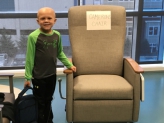Physical Properties of Drug-Resistant Leukemia Cells

Background
Drug resistance remains a major issue in the successful treatment of acute lymphoblastic leukemia (ALL). Physical changes have been described mostly in solid tumors, as aggressive tumors are softer than less aggressive ones. This characteristic allows them to spread in the patient’s body. In this application, we propose to analyze their physical properties, an unstudied aspect of drug-resistant leukemia cells. Thus far, we have discovered that drug-resistant leukemia cells have greater deformability than other leukemia cells that respond to chemotherapy.
Project Goal
In this project, we seek to measure the elasticity of drug-resistant leukemia cells and also break the increased deformability with a novel therapy targeting the structures that impact elasticity. Our efforts will potentially lay the groundwork for a new direction of research, diagnosis and therapy in the field of hematology and drug resistance.
Project Update - November 2020
Based on scientific data we had completed to date, we hypothesized that leukemia cells of patients who have relapsed after treatment, (labelled drug resistant leukemia cells), are biophysically softer (more elastic), than ALL cells that are responsive to drug treatment. Throughout the course of the ALSF grant, we were able to make progress in two ways. Firest, we were able to model, in the lab, the biophysical elasticity or deformability of leukemia cells. Deformability may explain how cancer cells “squeeze” through small spaces in the bone to areas that allow them to survive better and evade chemotherapy. We used cutting-edge technology to measure deformability with the assistance of our collaborator at UCLA, Dr. Amy Rowat. Up to this point, her method only measured deformability in breast cancer cells and one myeloid leukemia cell line. Measurements with this device are available within a few hours and therefore have a higher likelihood of being used clinically in the very near future. With this device, we have discovered that drug resistant cells are more deformable than their counterparts. Through our work, we were able to conclude that drug resistance makes leukemia cells softer, which could potentially create a path to evade chemotherapy. We are now preparing our findings for publication.
Secondly, we have studied blocking adhesion to the bone marrow, a process we believe contributes to the drug resistance of leukemia cells. This study, formalized in a peer-reviewed paper, has been accepted for publication in Frontiers Oncology. Our other goal was to test a proof-of principle: whether or not deformability can be impacted by blocking the adhesion of leukemia cells to the bone marrow, which has been proven to serve as a protective shelter from chemotherapy. We were able to demonstrate that targeting a specific adhesion molecule with an antibody called P5G10 can sensitize leukemia cells to chemotherapy. We used this antibody and showed that deformability of ALL cells can be reversed by interrupting adhesion to the chemoprotective bone marrow shelter.

